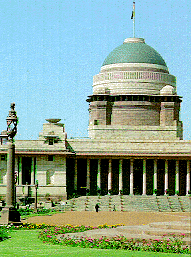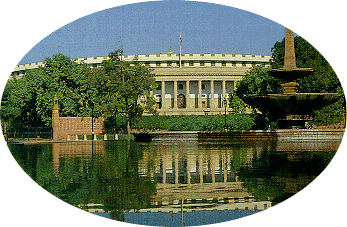Federal SystemIndia, a union of states, is a Sovereign, Secular, Democratic Republic with a Parliamentary system of Government. The Indian polity is governed in terms of the Constitution, which was adopted by the Constituent Assembly on 26 November 1949 and came into force on 26 November 1950. The President is the constitutional head of Executive of the Union. Real executive power vests in a Council of Ministers with the Prime Minister as head. Article 74(1) of the Constitution provides that there shall be a Council of Ministers headed by the Prime Minister to aid and advise the President who shall, in exercise of his functions, act in accordance with such advice. The Council of Ministers is collectively responsible to the Lok Sabha, the House of the People. In the states, the Governor, as the representative of the President, is the head of Executive, but real executive power rests with the Chief Minister who heads the Council of Ministers. The Council of Ministers of a state is collectively responsible to the elected legislative assembly of the state. The Constitution governs the sharing of legislative power between Parliament and the State Legislatures, and provides for the vesting of residual powers in Parliament. The power to amend the Constitution also vests in Parliament. The Union Executive consists of the President, the Vice-President and Council of Ministers with the Prime Minister at the head to aid and advise the President. President
The President is elected by members of an Electoral College consisting of elected members of both Houses of Parliament and Legislative Assemblies of the states, with suitable weightage given to each vote. His term of office is five years. Among other powers, the
President can proclaim an emergency in the country if he is satisfied that
the security of the country or of any part of its territory is threatened
whether by war or external agression or armed rebellion. When there is a
failure of the constitutional machinery in a state, he can assume to
himself all or any of the functions of the government of that
state Rashtrapati Bhavan. The Vice-President is elected by the members of an electoral college consisting of members of both Houses of Parliament in accordance with the system of proportional representation by means of a single transferable vote. He holds office for five years. The Vice-President is Ex-officio Chairman of the Rajya Sabha.
Council of MinistersThe Council of Ministers comprises Cabinet Ministers, Minister of States (independent charge or otherwise) and Deputy Ministers. Prime Minister communicates all decisions of the Council of Ministers relating to administration of affairs of the Union and proposals for legislation to the President. Generally, each department has an officer designated as secretary to the Government of India to advise Ministers on policy matters and general administration. The Cabinet Secretariat has an important coordinating role in decision making at highest level and operates under direction of Prime Minister. The Legislative Arm of the Union, called Parliament, consists of the President, Rajya Sabha and Lok Sabha. All legislation requires consent of both houses of parliament. However, in case of money bills, the will of the Lok Sabha always prevails.
Rajya SabhaThe Rajya Sabha consists of 245 members. Of these, 233 represent states and union territories and 12 members are nominated by the President. Elections to the Rajya Sabha are indirect; members are elected by the elected members of Legislative Assemblies of the concerned states. The Rajya Sabha is not subject to dissolution, one third of its members retire every second year. Lok Sabha
The Lok Sabha is composed of
representatives of the people chosen by direct election on the basis of
universal adult suffrage. As of today, the Lok Sabha consists of 545
members with two members nominated by the President to represent
the
The Parliament of
India State GovernmentsThe system of government in states closely resembles that of the Union. There are 25 states and seven Union territories in the country. Union Territories are administered by the President through an Administrator appointed by him. Till 1 February 1992, the Union Territory of Delhi was governed by the Central government through an Administrator appointed by the President of India. Through a Constitutional amendment in Parliament, the Union Territory of Delhi is now called the National Capital Territory of Delhi from 1 February 1992. General elections to the Legislative assembly of the National Capital Territory were held in November 1993.
Political SystemA recognised political party has been classified as a National Party or a State Party. If a political party is recognised in four or more states, it is considered as a National Party. Thirteen Lok Sabhas have been constituted so far. Except for the short-lived Sixth and Ninth Lok Sabha, the Congress Party ruled the country. The Sixth Lok Sabha functioned for about two years and four months and the Ninth Lok Sabha functioned for one year and two months. Even in the states, the regional parties or the non-congress parties have gained in importance over the years. The ruling parties in the states are listed below.
Judicial SystemThe Supreme Court is the apex court in the country. The High Court stands at the head of the state's judicial administration. Each state is divided into judicial districts presided over by a district and sessions judge, who is the highest judicicial authority in a district. Below him, there are courts of civil jurisdiction, known in different states as munsifs, sub-judges, civil judges and the like. Similarly, criminal judiciary comprises chief judicial magistrate and judicial magistrates of first and second class. Supreme Court
| |||
|
| |||
|
Polity | |||
|
Ministry Of External Affairs, India |


